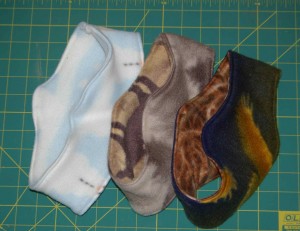
I needed an ear warmer to completely cover my ears!
I needed a ear warmer headband that would more completely cover my ears, so I measured where my ears are on my head,and came up with this simple design. I have made headbands for many of my friends and family, so it seems to work on other heads, too. It is another great way to use up small scraps of polar fleece and make something that can be used for many outside activities during the cold weather. It is also fun, because it is so fast and easy, satisfying both the desire to get a project done AND make several gifts quickly!
(I am updating how I deliver my pdfs. This pattern will be for sale for a low price in the near future. It will include an video. If you have signed up for my newsletter [link in upper left of website], you already have access to patterns that I have created on the sewing private resource page using the password sent to you. If you sign up for the newsletter, you Remember, you need to answer the confirmation email to get the email with the links! )
Be sure to print the pattern at only 100%
- When my computer opens the Adobe attachment, it automatically fits it to size the page, which seems to be 225%. No one with that big of a head at my house! You should be able to change the size to 100% with the Adobe menu bar that shows up if you hover your mouse at the bottom of the page. Click on the fancy A on the far right, and another menu bar will appear on the top. Slightly to the right of center is a box that lets you adjust the size according to percentage of original.
- The headbands work best if cut so that the slight stretch of the polar fleece is going around the circle. Also, don’t miss the fact that the pattern is to be cut on a fold.
- Cut two pieces of polar fleece that will be sewn together to make the double thick headband.
- Sew ONLY the long, curvy edges with a regular straight stitch. No need to reinforce or finish edges.
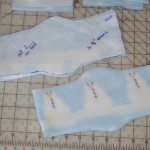
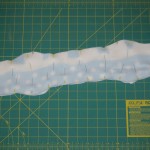
Turning it right sides out
I use my 12-Inch Straight Hemostat to turn the headband right side out. The hemostat is a great tool for turning ties, too. My husband has threatened to take the hemostats for his fishing tackle box because the pair he has is smaller…
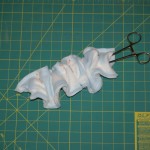
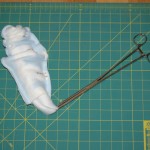
Once the headband is right side out, it can be helpful to use your fingers to press the seams open some. This will make the top stitching easier to do, but you will also have to keep working the seam some while sewing, to help the edges keep the shape as you top stitch. It is not hard, just something to be aware of and do.
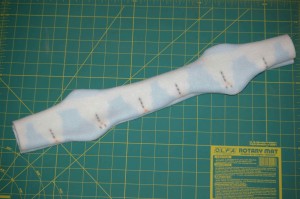
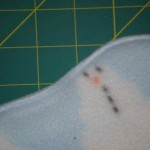
Top stitch about an 1/8 inch from the edge of the two long sides of the headband. The ends are still unfinished.

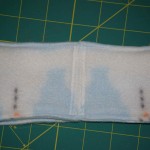
Making the top stitched edges even on both sides, pin all layers of the back seam together and sew in about a 1/4 inch seam.
If the person you are making the headband for is handy, this is a good time to try it on for a fit. Small adjustments can be made in the size of the back seam to make it smaller. If it needs to be bigger, I suggest finding another person for that particular headband, then cutting the next one a little longer on the ends.
Back to the sewing process of the one you are working on, use a couple of zig zag rows to sew the bulk of the seam down flat. The headband is complete!
If you want to make someone an extra special gift combo, may I suggest you make them a pair of convertible mittens to match their ear muff style headband? These mittens are great for running in the winter.
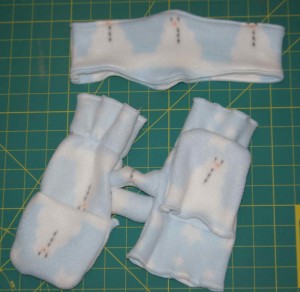
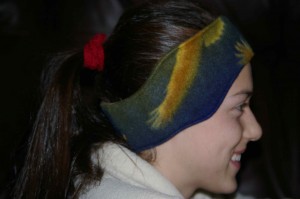
You can see on a couple of the examples in the very top photo that it is not necessary to use the same fabric for both layers of the headband. Since the back seam doesn’t show when the headband is worn, this makes it reversible. So, go dig into the small left over pieces of polar fleece that you weren’t sure what to do with and make some headbands!
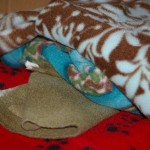

Man those are some NICE fishing pliers!
Okay, Jesse, thank you for your input….:-P
looks great – I’m going to make one of these tomorrow. Thanks for sharing! 🙂
Glad you can use the idea. It is that time of year again!
Thank you so much for sharing this! I had looked and looked for a pattern/tutorial but most of what I could find wasn’t shaped. I made one using your pattern and the fit was perfect! Thanks again!
So good to hear, Cindy! I use mine all the time. 🙂
I signed up for your email, put in the password and I can’t get it to work.
I just updated my website and that may have caused a glitch. I think I have fixed it and I will be sending an email out soon with the new password!
I signed up for you email, put in the my e-mail and the link would not connect, asked for e-mail again. I would like the pattern for the fleece ear warmer to make for Christmas gifts and it’s getting rather close. Thank you for any help you can give me.
Can you send your email address to me at laura@dailyimprovisations.com. Put your name in the subject line with “ear warmer”. I send you the information!
I keep clicking the link to get the pattern but nothing opens or downloads! Help! I’d love to make these for my girls for stocking stuffers before they get here Thursday!
Hi, Lori. So sorry that it isn’t working for you. If you will email me at laura@dailyimprovisations.com, I will send you the link to the pattern. Put your name and “ear warmer” in the subject line.
If you have trouble with getting the link button to work, please try refreshing the page. Other people have tested this for me and it works when they re-load the page. I recommend waiting until the page has completely loaded to try the link/button again. If you still have trouble, please let me know. I hope everyone is making some fun and warm headbands!